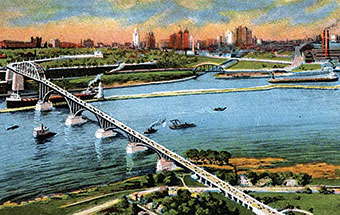Next story: Follow That Story
The Bridge Over the River Why?

Perhaps 30 people attended a panel discussion on the Peace Bridge expansion project Tuesday night in the Buffalo offices of Cornell University School of Industry and Labor Relations. It’s a pity there weren’t more: The conversations held there, on the 12th floor of 237 Main Street, often organized with the Partnership for the Public Good, are uniformly civil and informative. And the conference room affords a beautiful view of downtown Buffalo and Lake Erie.
The panelists at Tuesday’s forum were all critics of the $700 million proposal to build a second bridge and expand the US plaza, which sits beside an Olmsted park and a historic waterfront neighborhood, some of which is in decline and some of which is beautifully preserved. Two of the speakers—Tania Werbizky of the Preservation League of New York State and Roberta Lane of the regional office of the National Trust for Historic Preservation—focused on the potential impacts to the neighborhood’s historic assets. (“Most of the country is beyond this kind of planning,” Lane said of the project’s encroachment on a valuable, historic waterfront neighborhood, explaining why the National Trust chose to join those trying to stop the project.) Erin Heaney of the Clean Air Coalition spoke about high rates of asthma in the vicinity of the existing bridge and plaza, and broke down the components of diesel admissions, which, it turns out, are similar to the pollutants found in the air around the Tonawanda Coke plant against which the CAC has led a somewhat successful campaign. Bruce Fisher, a columnist for this paper and director for Buffalo State College’s Center for Economic and Policy Studies, argued that whatever economic justification there may have been for an expansion of the Peace Bridge’s capacity decades ago has been washed away by the region’s decline in manufacturing, the decline in bridge traffic, and the long-term transportation infrastructure plans of our neighbors in southern Ontario, whose regional economy is growing much faster than Western New York’s.
The panel was moderated by Anthony Armstrong of the Buffalo office of the Local Initiatives Support Corporation. When the speakers had said their piece, Armstrong opened the floor to questions, which afforded the lone representative for the Public Bridge Authority an opportunity to speak. Matthew Davison, who left a media relations job at the Erie Canal Harbor Development Corporation last summer to fulfill the same function for the PBA, asked the panelists how they would suggest the authority increase the bridge’s capacity and efficiency, so as to minimize the number of idling trucks spewing diesel fumes into the air, without expanding the plaza. In short, he said, what would you have us do?
Fisher replied that none of the panelists were experts in bridge management. His point, he said, was that the bridge project no longer made sense. Because the PBA does not realize sufficient revenue to pay for the project itself, it would rely on federal and state dollars to pay for it. But the region’s other infrastructure needs—he mentioned both water quality improvement via sewer system upgrades and investment in trains to match those contemplated by planners in Ontario—the expansion of the Peace Bridge has become a low priority for everyone except construction firms and unions hungry for work and the politicians who represent them.
In February, the Department of Homeland Security acknowledged that federal money for border infrastructure was not forthcoming in the near future, as a result of the current emphasis on deficit reduction. Last week, Congressman Brian Higgins sent a letter to the federal commissioner of Customs and Border Protection, asking that consideration for approval of the project be expedited, arguing that there was in fact money to pay for it: $2.2 billion in Department of Transportation funding marked for land ports of entry. Higgins also called for a new plan that would “consolidate the current plaza plan into a reduced footprint that will meet the homeland security needs of your agency as well as decreasing the project’s cost and expediting its movement.”
“We have not seen any drawings of a smaller footprint,” said a spokesperson for Higgins. “The congressman just wants to be absolutely certain that the negative impacts, particularly involuntary takings, are reduced to their smallest possible level before the process is finalized.”
—geoff kelly
blog comments powered by Disqus|
Issue Navigation> Issue Index > v10n16 (Week of Thursday, April 21) > Week in Review > The Bridge Over the River Why? This Week's Issue • Artvoice Daily • Artvoice TV • Events Calendar • Classifieds |









 Current Issue
Current Issue